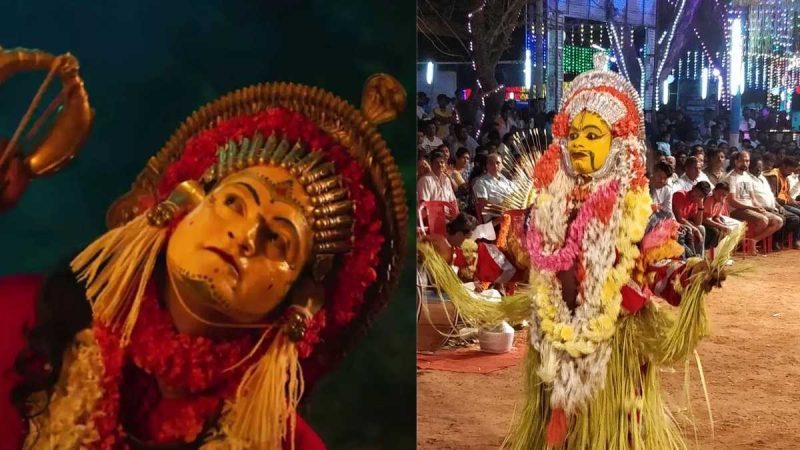If you ever find yourself in the coastal folds of Karnataka, stay up late one night. Follow the sound of drums echoing through the palms. You’ll come upon a clearing lit by oil lamps, the air thick with incense and anticipation. And then, the moment: a man in fierce makeup, towering headgear, and bells on his ankles begins to move. He is slow at first, then faster, until the line between man and spirit blurs. That is Bhoota Kola!
The Mystical World Of Bhoota Kola
This centuries-old ritual belongs to the Tulu-speaking communities of Dakshina Kannada, Udupi, and parts of northern Kerala. The name translates loosely to “the play of the spirit.” But calling it a performance barely does it justice. Bhoota Kola is worship, theatre, and trance woven together; it’s a conversation between the living and the divine.
The spirits, or bhootas, are no distant gods. They are guardians of the land; they’re the protectors, ancestors, and sometimes even local heroes like Kallurti and Kalkuda, or nature-linked forces such as Panjurli, the wild boar deity. Every ritual follows a rhythm: the recitation of oral epics known as Paddanas, the deepening beat of drums, the scent of burning camphor, and finally the transformation. The performer, often from families like the Nalike, Pambada, or Parava, enters a trance, believed to be possessed by the spirit itself. From that moment, it is the deity who speaks, settling disputes, blessing the faithful, and guiding the community.
Also Read: Diwali On A Karnataka Plate: 6 Traditional Sweets And Snacks You Can’t Miss
Rituals, Music, And Trance: The Sacred Process Of Bhoota Kola
Bhoota Kola usually takes place between December and May, when the coastal air turns heavy and festive. It’s not a spectacle staged for outsiders; you won’t find tickets or schedules. The rituals unfold in village shrines or Daivastanas, where the community gathers year after year to keep the tradition alive.
Still, glimpses of it have reached beyond Karnataka. The Kannada film Kantara (2022) turned Bhoota Kola into a visual revelation, its fiery climax introducing millions to this mysterious ritual. It’s streaming on Amazon Prime Video if you want to see that raw power onscreen. For something closer to the real thing, filmmaker Deepak R. Hegde’s documentary KOLA (2025) on YouTube offers an unfiltered look at the people who carry this legacy.
Also Read: Karnataka Becomes India’s First State To Grant 12 Menstrual Leaves To All Women Employees
Where To Witness Bhoota Kola?
Along the rugged, coconut-fringed coastlines of Karnataka, in Dakshina Kannada and Udupi districts, an ancient heartbeat still resonates. Bhoota Kola is the ritual where spirits and humans converse. This isn’t entertainment for tourists. It’s lived, raw, and communal, performed in Daivastanas, the village temples where devotees and ancestral or nature-linked spirits intersect.
In Dakshina Kannada, places like Mangaluru, Bantwal, and Sullia pulse with kola energy at certain nights of the year. Kadandale, anchored by the Subramanya Temple and overseen by the Kadandale Guthu family, becomes a pilgrimage hub when devotees gather for the annual rituals. Nearby, Shamboor and Barla Guthu erupt with ancestral presence as spirits like Panjurli and Kalkuda awaken, dispensing blessings or stern guidance to those who seek it. In Mansa Punnodi, close to Kavoor, performers enter trance states so intense they almost vanish into the spirit world, leaving only the divine presence in their stead.
Udupi district hums with a kola heritage that feels alive in every village lane. In Muloor, the Sri Bobbarya-Kodamanithaya Daivastana becomes a stage for the boar deity Panjurli, whose presence is felt in every tremor of the drum and every sway of the performer. Come April-May, and you’ll see Hiriadka erupt into the Siri Utsava, a spectacle where spirits like Kallurti and Kalkuda move through the bodies of performers. Katpady and Barkur, with their centuries of stone and story, host kolas that don’t merely happen, they thread generations together.
Beyond Karnataka, in northern Kerala’s Kasaragod district, the Tulu-speaking communities of Manjeshwar and Uppala keep the kola flame alive. Here, performances spill beyond temple walls into courtyards and open grounds, proving that this spirit worship doesn’t heed borders. It belongs to the land, to the lineage, and to the people themselves.
For a traveller, Bhoota Kola isn’t something to check off a list. It demands patience, humility, and a willingness to step into a world where drums speak, spirits answer, and history is not just remembered, it is lived. Those who wish to witness it usually base themselves in Mangaluru or Udupi, following whispers from local shopkeepers, temple caretakers, or rickshaw drivers to find the kola that night.
Also Read: Diwali On A Karnataka Plate: 6 Traditional Sweets And Snacks You Can’t Miss
Bhoota Kola isn’t a show, it’s a dialogue between belief and belonging, land and legend, and human and divine. And if you ever watch it in person, under a canopy of flickering lamps, you’ll understand why the people of Tulu Nadu still bow when the drums begin.
Cover Image Courtesy: pramodshetty06/WikimediaCommons and primevideo
For more such snackable content, interesting discoveries and the latest updates on food, travel and experiences in your city, download the Curly Tales App. Download HERE.

